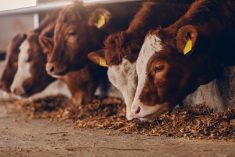When it comes to making a decision on backgrounding calves, it’s important to look at all of the costs involved.
“High forage prices this summer and fall have predominated farm discussions at coffee shops, auction markets and social media outlets the last few months,” says Ted Nibourg, farm business management specialist, Alberta Ag-Info Centre, Stettler.
“At this time of year the profitability of backgrounding calves also comes into question. Hay is usually a major component of backgrounding rations. However, focusing on just the feed costs can give the impression that backgrounding will be economically feasible this fall. While feed costs are a major part of any production system, they are certainly not the only ones. Numerous other costs are involved, and risk management has to be considered as well.
Read Also

Body condition, nutrition and vaccination for brood cows
One of the remarkable events of the past century related to ranching has been the genetic evolution of brood cows….
“Using an example with current feeder prices can illustrate a cost-of-production scenario for a backgrounding operation,” says Nibourg. “The example involves taking six-weight steers to eight-weights gaining about two lbs./day.
“Using Alberta prices from mid-October Nibourg calculated that steers averaging 650 lbs. in central Alberta sold for an average of $263/cwt for a total cost of $1,710/head. Eight hundred and fifty-lb. steers averaged $243/cwt for a $2,066 value. Assuming the price on eight-weights holds, the profit potential is $356/head before expenses. Now, let’s look at all the costs.”
The two-lbs./day gain will likely take about 20 lbs. of feed per day consisting of six lbs. of barley and 14 lbs. of hay, each component averaging 10 cents/lb. A 100-day feeding period will cost approximately $200 leaving $156/head profit potential. If feed is the only cost considered, this leaves a healthy profit even with strong hay prices. However, other costs also come into play.
“Yardage can run about 50 cents/head/day, which leaves $106,” explains Nibourg. “A one per cent death loss will pull an additional $17 out of the mix. Carrying cost at five per cent on feeders drags the profit down another $23/head. Commissions will reduce the net another $22/head, leaving $44/head. Trucking, checkoffs and brand inspection can easily add $14/head. As such, total expenses add up to about $326 leaving a $30 margin. Feed costs could amount to 61 per cent of total costs for a typical backgrounding operation.
“The $30 margin is dependent on eight-weight steers staying at $243/cwt,” says Nibourg. “Risk management is a cost that is difficult to calculate. As of Oct. 15, the Western Livestock Price Insurance Program (WLPIP) for feeders will guarantee a price of only $208/cwt for a premium cost of $54/head, leaving a negative $24/head margin if one chooses to go that route. The break-even price for the example cited would be $240/cwt for 850-lb. steers. Basically, the WLPIP will only mitigate a price wreck and should not be looked upon as a profit centre in this scenario. The profit would have to come from a bullish market for feeders going forward.”
















